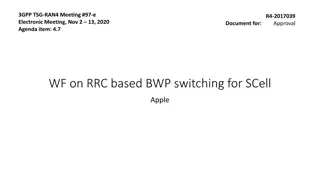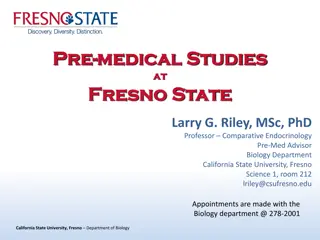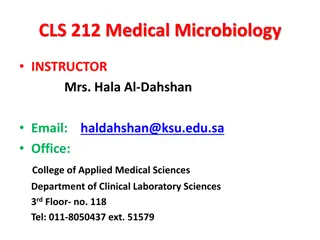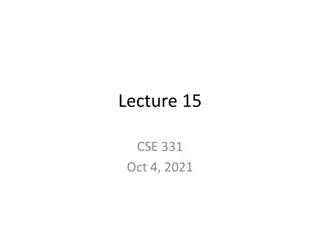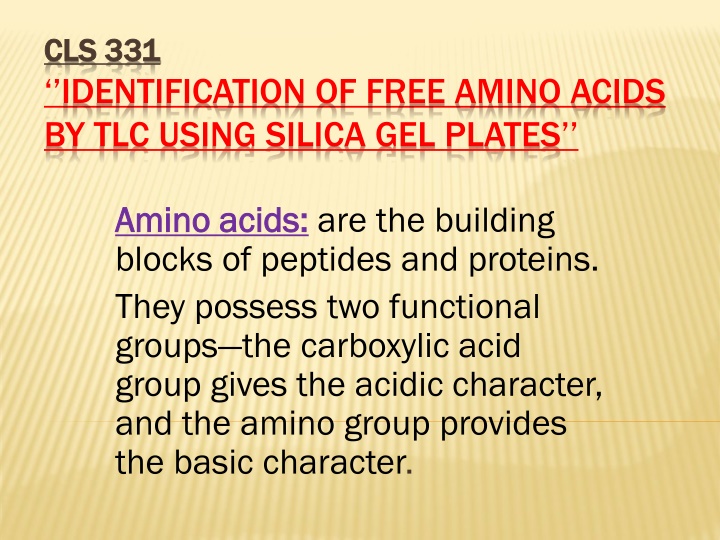
Identification of Free Amino Acids by TLC Using Silica Gel Plates
Explore the general structure and properties of amino acids, the essential amino acids, and the different types of chromatography techniques used for their analysis, including thin-layer chromatography (TLC) with silica gel plates. Learn how the functional groups and side chains of amino acids impact their migration in TLC, aiding in their separation and identification.
Download Presentation

Please find below an Image/Link to download the presentation.
The content on the website is provided AS IS for your information and personal use only. It may not be sold, licensed, or shared on other websites without obtaining consent from the author. If you encounter any issues during the download, it is possible that the publisher has removed the file from their server.
You are allowed to download the files provided on this website for personal or commercial use, subject to the condition that they are used lawfully. All files are the property of their respective owners.
The content on the website is provided AS IS for your information and personal use only. It may not be sold, licensed, or shared on other websites without obtaining consent from the author.
E N D
Presentation Transcript
CLS 331 CLS 331 IDENTIFICATION OF FREE AMINO ACIDS BY TLC USING SILICA GEL PLATES Amino acids: Amino acids: are the building blocks of peptides and proteins. They possess two functional groups the carboxylic acid group gives the acidic character, and the amino group provides the basic character.
GENERAL GENERAL STRUCTURE OF STRUCTURE OF AN AMINO AN AMINO ACID: ACID: R R denotes the functional group of the amino acids. The acidic COOH and basic NH2groups react with one another to form an internal salt called a zwitterion. H I R-C-COOH I NH2
There are 20 amino acids derived from proteins. Of the 20 amino acids, 11 can be synthesized in the body. That leaves nine amino acids that you need to get directly from your diet. Those nine amino acids are called "essential amino acids." http://t0.gstatic.com/images?q=tbn:ANd9GcRNpfrG_45z1exXxvXI5470fyppyeEvtL18ryxHEZDkUT8WsXEWLO-HpoY
Some amino acids are polar(hydrophilic) e.g. Serine, tyrosine. And some are nonpolar (hydrophobic) e.g. Glycine, alanine.
The different side chains, and the solubilities provided by these side chains, affect their rate of migration in thin-layer chromatography (TLC). Chromatography Chromatography: is the collective term for a set of laboratory techniques for the separation of mixtures of substances into their components.
TYPES: TYPES: 1. 1. Column chromatography; in a tube. Column chromatography; in a tube. 2. 2. Planar chromatography Planar chromatography a) a) Paper chromatography Paper chromatography b) b) Thin layer chromatography Thin layer chromatography They all have a stationary phase ( solid, or a liquid supported on a solid) and a mobile phase ( a liquid or a gas).
Thin layer chromatography: Thin layer chromatography: Is done using a thin, uniform layer of silica gel or alumina coated onto a piece of glass, metal or rigid plastic. the silica gel is the stationary phase, and it also often contains a substance which fluoresces in UV light...
Thin layer Thin layer chromatography chromatography
The reason for covering the beaker is to make sure that the atmosphere in the beaker is saturated with solvent vapour. As the solvent slowly travels up the plate, the different components of the dye mixture travel at different rates and the mixture is separated into different coloured spots.
METHOD: METHOD: 1. Preparation of the silica gel plates. 2. A pencil line is drawn near the bottom of the plate and a small drop of a solution of the mixture is placed on it. 3. When the spot of mixture is dry, the plate is stood in a shallow layer of solvent in a covered beaker.
4. WHEN THE SOLVENT FRONT IS ABOUT 15 CM, REMOVE THE PLATE AND DRY IT. 5. locate the a.a by spraying with the ninhydrin solution. 6. place the plate in a drying oven at 110 c,10 minutes. Calculation: Rf value= distance travelled by component distance travelled by solvent




